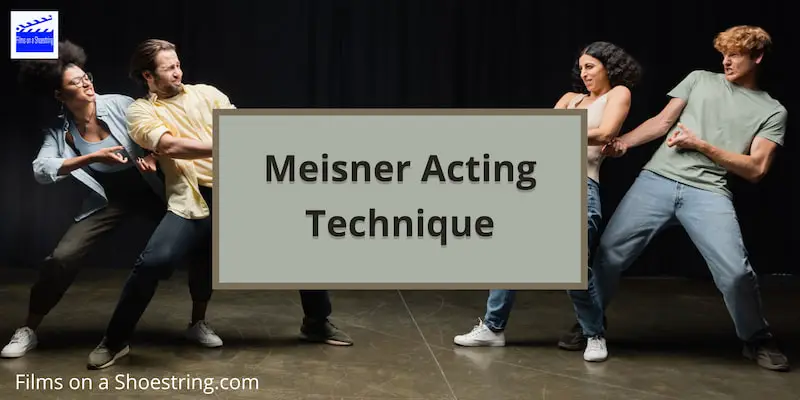Discover more about the Meisner Acting Technique, one of the ways actors bring authentic performances to their audiences.
The Meisner acting technique is a unique approach developed by American actor and teacher Sanford Meisner.
- The goal of this technique is to shift the actor’s focus away from themselves and onto the other actors in the scene.
- Instead of getting caught up in their own thoughts and emotions, Meisner encourages actors to truly listen and connect with their scene partners.
- One of the key exercises in the Meisner technique is the Repetition Exercise, where actors respond to each other through a repeated phrase, gradually shifting the focus from external characteristics to their behavior and emotions.
- This technique helps actors develop improvisation skills and bring authenticity to their performances.
- It’s all about embracing who you truly are and responding genuinely in the moment.
What is the meisner technique and what are its benefits for actors?
The Meisner technique is a popular acting approach developed by American actor and teacher Sanford Meisner. It focuses on deepening an actor’s connection to their emotions and the present moment. This technique encourages actors to fully immerse themselves in the circumstances and emotions of the scene, allowing for authentic and organic performances.
One of the key benefits of the Meisner technique is its emphasis on listening and responding. Actors trained in this technique become adept at actively listening to their scene partners, allowing for genuine and spontaneous reactions. This heightened level of concentration and responsiveness adds depth and authenticity to their performances.
Another advantage of the Meisner technique is its emphasis on emotional truth. Through a series of exercises, actors are encouraged to tap into their own emotions and connect with the feelings of their characters. This exploration of authenticity allows actors to create emotionally complex and compelling performances.
Furthermore, the Meisner technique helps actors develop a strong sense of presence and responsiveness in the moment. The technique requires actors to be fully present in the here and now, reacting truthfully to their scene partners and the given circumstances. This ability to be fully present allows actors to create dynamic and engaging performances.
Additionally, the Meisner technique promotes the development of strong instincts and impulses. It encourages actors to trust their reactions and instincts, enabling them to make bold choices in the moment. This sense of spontaneity and trust in one’s impulses can lead to surprising and powerful performances.
The Meisner technique is a valuable tool for actors seeking to deepen their connection to their characters and the moments on stage or in front of a camera. Its emphasis on listening, emotional truth, presence, and trusting one’s instincts allows actors to create authentic and engaging performances that resonate with audiences.
Meisner Training
Acting Class: What is the Meisner Technique? | Living Truthfully Under Imaginary Circumstances
In this video, acting teacher Jessica Houde-Morris talks about the famous Meisner technique. Jessica explains the foundation of connecting, listening, and being present through behavior and living truthfully with a partner before jumping into dialogue. Repetition is the foundation of the technique and the actors must connect and be present with their partner while focusing on making it about the team instead of the individual. She emphasizes the importance of acting truthfully under imaginary circumstances using the Meisner technique to create deep and impactful stage, film and television performances.
Topics covered in the video:
I. Introduction
– Explanation of the Meisner technique
II. Foundation of Connecting, Listening, and Being Present
– Importance of living out a relationship just through behavior before dialogue
– Exercises to help actors focus on their relationship with their scene partner
– Emotional preparation and living truthfully emphasized
– Breaking down the scene and objectives after the foundation is established
III. Benefits of Taking Jessica’s Online Classes
– Improvement of self-tapes and technical aspects
– Individualized attention
– Benefits for beginners
IV. History and Philosophy of Meisner Technique
– Meisner’s approach on living in the moment
– Daydreaming as an emotional preparation method
– Developing exercises beyond repetition
V. Repetition Game
– The foundation of the technique
– Teach actors to listen, respond and make it about the team, not individuality
VI. Self-Tape Class
– Importance of self-taping for actors
– Teaching actors to create self-tapes equal to or better than those done by working actors
– Individualized attention for a suitable self-tape setup
VII. Conclusion
– 2 teachers for different aspects of the class
– Improvement across weeks through scene analysis
Focus of the Meisner Approach
If you’re an aspiring actor or someone interested in the world of acting, you’ve probably come across the Meisner acting technique. Developed by American actor and teacher Sanford Meisner for group theatre, this approach is designed to help actors focus on their immediate environment and the other actors they are interacting with rather than on themselves.
The Meisner technique emphasizes the importance of truly listening and responding to the other actors, with the aim of creating genuine and authentic moments on stage or in front of the camera. Unlike other acting techniques that focus on internal thoughts and feelings, Meisner encourages actors to be present in the moment and react spontaneously to their surroundings.
To train actors in this technique, Meisner created a series of training exercises that gradually become more complex. These exercises help actors develop their ability to fully embody a character and bring their emotional life to the forefront. From simple repetition exercises to more nuanced improvisation work, the Meisner technique allows actors to access a rich range of emotional responses and bring them to the text.
One of the signature exercises of the Meisner technique is the Repetition Exercise. In this exercise, two actors sit across from each other and repeat a phrase, initially focusing on external physical characteristics and later delving into their behavior and emotional responses. Through this exercise, actors learn to let go of preconceived ideas and respond more freely and authentically to their scene partner.
Beyond the Neighborhood Playhouse School
The Meisner technique has had a significant impact on the field of acting, with many actors and teachers incorporating its principles into their own work. It has been praised for its ability to cultivate strong improvisation skills and help actors develop a deeper understanding of their characters.
While Meisner developed his approach to acting technique during his time at the Neighborhood Playhouse in New York in the 1930s, his teachings continue to resonate with actors today. His emphasis on authenticity and embracing one’s true self has become a guiding principle for many actors seeking to create compelling and truthful performances.
Must be Authentic
The Meisner acting technique is a powerful approach that encourages actors to be fully present, attentive, and responsive to their scenes and fellow actors. By focusing on the immediate environment rather than their internal thoughts, actors can create genuine and authentic moments on stage or in front of the camera. The Meisner technique’s emphasis on listening, responding, and embracing one’s authentic self has had a profound influence on the field of acting and continues to be highly regarded by actors and teachers alike.
What is the meisner technique for acting?
The Meisner technique for acting is a prominent approach that focuses on an actor’s ability to truly connect with their emotions and their fellow actors. It emphasizes living truthfully in imaginary circumstances, allowing actors to respond authentically in the moment. Developed by Sanford Meisner, this technique is rooted in the idea that truthful acting comes from genuine emotional experiences and reactions. It encourages actors to focus on listening and observing their scene partners, allowing for organic responses rather than pre-planned or rehearsed actions. Through repetition exercises, actors are encouraged to deeply absorb their partner’s words and actions, in turn, sparking genuine emotional reactions. This technique is known for its emphasis on spontaneity and the exploration of the actor’s inner emotional life. It helps actors to become in tune with their own feelings and instincts, enabling them to create rich and believable characters on stage or screen. By fully engaging with the Meisner technique, actors can tap into their emotional range and connect with both their own truth and the truth of the character they are portraying.
How long does it take to learn the whole meisner technique?
It can take varying amounts of time to fully grasp and master the Meisner Technique. Learning the foundation of this acting technique typically requires a commitment of several years. To truly internalize and embody the principles of the Meisner Technique, you will need to dedicate yourself to consistent practice and study. Initially, you may spend a few months or even a year to understand the basics and gain a solid understanding of the technique. However, it is important to note that true mastery of this technique is an ongoing process that continues throughout an actor’s career. As you progress and gain experience, you will continue to refine and deepen your understanding of the Meisner Technique. So, while there is no fixed timeline to learn the whole Meisner Technique, it is a continuous journey of growth and development as an actor.
What is the difference between method acting and the meisner technique?
When it comes to the art of acting, there are various techniques and methods used to bring characters to life. Two popular approaches are method acting and the Meisner technique. Method acting, famously associated with actors like Marlon Brando and Robert De Niro, involves immersing oneself deeply into a character’s emotions and experiences. Actors using the method technique often draw from their own personal memories and emotions to authentically portray a character’s feelings. This approach encourages actors to fully embody their characters even off-screen, blurring the lines between their on-stage or on-camera personas and their real-life selves.
On the other hand, the Meisner technique, named after its creator Sanford Meisner, focuses more on present moment experiences and the actor’s ability to respond truthfully to their scene partners. Actors utilizing this technique rely heavily on active listening and being fully present in the given circumstances of the scene. Unlike method acting, which delves into past experiences for emotional depth, the Meisner technique prioritizes spontaneous and organic reactions in the moment. This technique emphasizes the importance of observation, allowing actors to fully engage with their scene partners and genuinely react to whatever arises during the course of a scene.
Though method acting and the Meisner technique serve different purposes and emphasize different aspects of the craft, both aim to bring authenticity and truthfulness to a performance. Method acting dives deep into a character’s emotional history, while the Meisner technique emphasizes the actor’s ability to respond spontaneously and genuinely. Both techniques have produced remarkable performances from actors across different eras and genres, demonstrating the versatility and power of these methods in creating compelling characters on stage and screen. Ultimately, the choice between these techniques depends on the actor’s personal style and preferences, as well as the demands of a particular role or project.
Do actors think it is easier to learn method acting or the meisner technique?
When it comes to learning method acting or the Meisner technique, actors may have different opinions on which is easier. Some actors may find method acting to be more accessible and straightforward to grasp, while others may feel that the Meisner technique is easier to understand and implement. It ultimately depends on the individual’s personal preferences, learning style, and previous acting experiences. Method acting involves immersing oneself in the character’s thoughts, emotions, and life experiences, often drawing from one’s own experiences to create authentic performances. This approach can be intensive and requires a deep level of emotional commitment, which some actors may find challenging. On the other hand, the Meisner technique focuses on living truthfully in imaginary circumstances, emphasizing listening and responding genuinely to fellow actors. This method encourages spontaneity and relies less on personal experiences, which may be considered easier for some actors to grasp. However, both methods require dedication, practice, and a willingness to explore the depths of a character’s psyche. Overall, the perceived difficulty in learning method acting or the Meisner technique may vary among actors, and it is important for each individual to find their own preferred method of training and personal growth in their craft.
Who practices the meisner acting technique?
Many renowned actors have been known to incorporate the meisner technique into their craft, including the late movie star Grace Kelly, and veteran actors Robert Duvall, Diane Keaton, and Jeff Goldblum. However, it’s not just limited to established actors.
The meisner technique is also popular among aspiring actors who are honing their skills and seeking to improve their emotional depth and authenticity on stage or screen. So, whether you’re a seasoned professional or a passionate beginner, the meisner acting technique offers valuable tools and approaches to help you bring truth and depth to your performances.
What are the components of meisner technique?
First and foremost, the Meisner acting technique emphasizes the importance of truthful, authentic emotional responses. Through exercises and improvisations, you are encouraged to tap into your own genuine emotions and connect with your scene partner on a deep and honest level. Another crucial aspect of the Meisner Technique is its focus on active listening. This means fully engaging with your scene partner, paying close attention to their words, actions, and reactions, and responding spontaneously and honestly in the moment. The technique also places great emphasis on repetition exercises, which involve repeating simple phrases and actions to cultivate present-moment awareness and emotional truthfulness. Furthermore, the Meisner Technique encourages actors to embrace and fully commit to their instincts and impulses, fostering a sense of risk-taking and boldness in their performances. Overall, the components of the Meisner Technique work together to create a foundation of authenticity, emotional truth, active listening, and uninhibited expression for actors to draw upon in their craft.
How is the meisner acting technique different from other methods?
The meisner acting technique stands out from other methods due to its unique approach and emphasis on truth and authenticity in performances. Unlike other techniques that focus on external factors such as physicality or memorized techniques, the meisner technique delves deep into the emotional truth of a character. It encourages actors to fully immerse themselves in the given circumstances of a scene, allowing them to genuinely react and respond in the moment. Meisner actors believe in the importance of listening and responding truthfully to their scene partners, rather than relying on preconceived notions or predetermined choices. This technique emphasizes the actor’s ability to fully embody the essence of the character, connecting to their own emotional truth and bringing that rawness to the performance. Thus, the meisner acting technique sets itself apart by prioritizing genuine emotional connections and authentic responses within the realm of acting.
Purpose of repetition exercise is meisner?
The purpose of the repetition exercise in the Meisner technique is to foster authentic and spontaneous acting by emphasizing listening and reacting. By practicing repetition with a partner, you are encouraged to truly listen to what they are saying and respond honestly in the moment. This exercise aims to break down any preconceived notions of how a scene should play out and helps actors tap into their instincts. Repetition also enhances the actor’s ability to be present and fully engaged with their scene partner, creating a sense of immediacy and truthfulness in their performance. Through this exercise, actors deepen their connection to their emotions and develop a deeper understanding of their character by living truthfully under imaginary circumstances. It serves as a fundamental building block in Meisner training to bring about truthful and organic performances.
What types of exercises do meisner actors do?
As a Meisner actor, you engage in a variety of exercises to enhance your acting abilities. One key exercise is known as “repetition,” where you and your scene partner repeat a simple phrase or action while focusing on the organic response flowing from your partner’s behavior. This exercise helps develop your ability to listen and respond truthfully in the moment. Another important exercise is the “emotional preparation,” where you explore imaginary circumstances and allow yourself to experience the character’s emotions authentically. By connecting with your character’s emotions, you develop a deeper understanding of their inner life and bring a heightened level of truth to your performances. Other exercises involve working on specific elements like physical actions, objectives, and obstacles to build a strong foundation for your character development. Through these exercises and more, Meisner actors refine their skills in presence, spontaneity, emotional availability, and truthful communication on stage or screen.
How do you act with the meisner technique?
When you engage with the Meisner Technique, you approach acting with an open mind and a genuine connection to the present moment. You focus on truly listening and responding to your scene partner, allowing for spontaneous and authentic reactions to unfold. By fully immersing yourself in the circumstances of the scene, you let go of preconceived ideas and tap into your emotions and instincts. This technique encourages you to trust your impulses and embrace vulnerability, as you strive to become fully present in each moment. Through repetitive exercises and deep exploration of the given circumstances, you develop a deep understanding of your character, allowing you to respond truthfully and spontaneously to the imagined reality of the scene. As you practice the Meisner Technique, you learn to shed any self-consciousness and instead cultivate an experience of true connection and emotional depth with your fellow actors and the audience.
Where does the meisner acting technique come from?
The Meisner acting technique originates from the teachings of Sanford Meisner, an American actor and acting teacher. He developed this technique while studying and teaching at the Neighborhood Playhouse School of the Theatre in New York City. Meisner’s approach to acting focuses on cultivating truthful and authentic emotional responses in actors. He emphasized the importance of living in the moment and reacting truthfully to one’s environment and scene partners. The Meisner technique is known for its emphasis on repetition exercises, where actors engage in an exchange of lines while paying close attention to each other. This technique helps actors develop their listening skills and allows them to respond spontaneously and truthfully to their scene partners. Sanford Meisner’s impact on the acting community is significant, as his technique continues to be taught and practiced by actors and acting schools around the world.
What does emotional preparation actually mean?
Emotional preparation in the Meisner technique refers to the process wherein an actor prepares themselves emotionally before performing a scene or taking part in an exercise. It involves the actor connecting with their authentic emotions in order to portray a character in a genuine and believable manner. To achieve this, actors in the Meisner technique are encouraged to delve into their own personal experiences, memories, and imagination, allowing themselves to feel the emotions associated with the given circumstances of the scene. This emotional preparation enables actors to establish a strong emotional connection with their character and the scene, leading to truthful and organic performances. By engaging in this process, actors can tap into their own emotional reservoir and respond truthfully to their scene partners, ultimately creating a sense of spontaneity and truthfulness on stage or screen. Through repeated practice and honing of emotional preparation techniques, actors can develop a heightened emotional responsiveness and become more present and connected in their performances.
How can you learn to act with the meisner technique?
If you’re interested in learning to act with the Meisner technique, there are a few steps you can take to start your journey.
Firstly, it would be beneficial to find a reputable acting school or training program that offers Meisner technique classes.
Look for experienced instructors who have a thorough understanding of the technique and can guide you through its principles and exercises.
Once you’ve found a suitable program, begin by attending regular classes to learn the foundations of the technique.
The Meisner technique focuses on being present, listening, and responding truthfully in the moment. Through various exercises and repetition work, you can improve your ability to connect with your emotions and your scene partners. Dedicate time and effort to practicing and implementing the technique in scenes and improvisations.
Additionally, watching performances by actors who are known for their use of the Meisner technique can further enhance your understanding and inspire your own acting.
Remember, learning the Meisner technique is a gradual process, so be patient with yourself and allow yourself to grow as an actor over time.
Where can you study the meisner technique?
If you are interested in studying the Meisner technique, there are numerous places where you can pursue this training.
One option is to enroll in an acting school or conservatory that offers specific courses or programs focused on the Meisner approach.
The Neighborhood Playhouse school in New York City, the Maggie Flanigan Studio, and the William Esper Studio are renowned for their Meisner training.
These institutions provide a structured curriculum that guides students through the various aspects and exercises of the technique.
Additionally, many universities and colleges with performing arts programs offer Meisner classes as part of their curriculum. These courses may be available as electives or as part of a comprehensive acting program.
It’s also now possible to study these acting methods online.
It is important to research and consider the reputation and faculty of any institution before making a decision to ensure you receive quality instruction in the Meisner technique.
What other acting techniques should you know?
Take a look at our article on the acting techniques to build a believable character, which includes the techniques developed by Stanislavski, Uta Hagen, Stella Adler, Lee Strasberg, and other notable acting teachers of the nineteenth and twentieth century.
You can still buy many of the books written by these famous acting teachers.
More for Actors
- Casting Agents UK: What You Need To Know
- What Makes a Good Actor?
- How to Act Drunk for Actors on Stage and Screen
- Brechtian Acting Techniques & Exercises
- Film Set Etiquette: Professional Behaviour on Set
- What Do Actors Do If They Don’t Make It?
- Acting Terminology
- Self Tape Audition Mistakes to Avoid
- Meisner Acting Technique
- Can You be an Actor and a Filmmaker?
- How Do Actors Cry?
- How Do Actors Remember Their Lines?
- Can Actors Drink Alcohol on TV?
- Allen & Abel Acting Agency
- Do actors have personalities?
- Will Actors be Replaced by Robots, CGI or AI?
- Are Actors Smart?
- How Does An Actor Get A Role?
- Can Actors Have Tattoos?
- Casting Type: What Actor Type Are You?






















